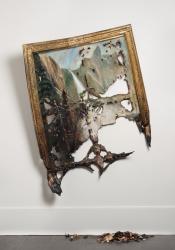Environmentalism and Environmental Art
Environmentalism is a social movement that is focused on protecting and conserving the environment that began in the 1960s (Lovelady). After World War II, America had a great surge in technology, consumer products, and synthetic materials which created an economic boom increasing the development of new cities resulting in pollution becoming a major concern (Lovelady). Awareness about the environmental destruction in the modern world were recognized by scientist, scholars, environmentalists and activists. (Lovelady). During this time, people began to fight for protection of their land and the beginnings of conservation measures such as the Environmental Policy Act in 1970, Clean Air and Water Act which created for a safer and environmentally friendly place (Lovelady). As technology and development have been increasing rapidly over the years, pollution and deforestation have been increasing. The destruction of the ecosystem causes negative impacts such as less biodiversity or protection of animals, and possible results of inhabitable lands, so there needs to be some sort of awareness to be spread about environmental conservation. There needs to be change in people with their lifestyles to make differences in carbon footprint or reduce waste, and we need support from individuals everywhere to help make an impact.
For centuries, art has been used to raise awareness, to tell a story, and change people’s perspective on a certain cause, for example, discrimination, violence, and historically significant events. Environmental Art is no different and is meant to address environmental issues that rose in the 1960s with environmentalism (Phillips). Environmental art uses many different types of media and forms of art such as sculpture, photography, and paintings (Marks M. et al., 2017), and has a goal of informing us about nature, our eco-system and damage to the environment (Phillip). Most artists use art form to evoke emotion in people to bring awareness, and conversation to inform the viewer or reader about our ecosystem. For example, in an exhibition called Nature’s Nation: American Art and Environment in Salem, Massachusetts, a 19th century painting of “Bridal Veil Falls, Yosemite” by Albert Bierstadt is displayed next to the same painting, but instead, the painting is destroyed and is called “Fallen Bierstadt” by Valerie Hegarty (Tugend, 2019). The shocking contrast of a beautiful untouched landscape painting next to one that is destroyed with burns and rips can strike conversation about how people are impacting this earth. A foreshadowing art piece about the destruction of our environment that warns us about the need for change. In the exhibition show, “Hudson Rising” in New York, there is a chronological display of the Hudson River from the 1800s from the building of the Erie Canal to today that shows the impacts of the tourism and the climate change (Tugend, 2019). One must reflect on environmental conservation when viewing such art works. However, why use this form of media to convey a message? Is environmental art any effective in getting the message across and changing the perspectives of the viewers?
Studies have shown environmental art is an effective tool in educating people about the environment. In Australia and United Kingdom, the Biosphere Reserves (BR), which is an environmental program, conducted a research to show the impacts of environmental art and education (Marks et al., 2017). Participants who were present at the festival and workshops that consisted of environmental art organized by BR were invited to complete a survey, and interviews to gauge the level of engagement, environmental attitudes, change in behavior from participating (Marks et al., 2017). The results of this experiment were that there was strong education shown because the artworks inspired dialogue and reflection, and a sense of place (Marks et al., 2017). For example, one artwork was the sculpture of the julara fish by Simon and Adrienne McVerry, and a workshop with the artists help educate the importance of the fish in the lake ecosystem and using materials that are natural and eco-friendly (Marks et al, 2017). The results of the workshops showed that the participants would use natural materials for art, they understood more about the lakes and the ecosystem, and helped people to question their own relationship with the environment and make positive changes. This is an example of “art influencing life” as Oscar Wilde mentions in “The Decay of Lying”. Environmental art attracts people and create a sense of place and attachment which in turn influences people to change their perspectives from reflection. Using the beauty of the arts to attract people and create a stronger connection from emotional response such as passion and appreciation of nature from the active engagement.
Environmental art is using the aesthetic to change perception of the viewer. To raise awareness through art and evoke emotion. In Oscar Wilde’s the “Decay of Lying”, using “lying” or art to spread awareness is an effective way to gain the empathy of others to hope for change. Although its not realistic that pollution and destruction of land would cause such a drastic response such as the “Fallen Bierstadt” by Valerie Hegarty, it does evoke strong emotion and reflection to make people be aware on how they can change their day to day lives to protect the environment which in the end will most likely bring change to us. The use of aestheticism to change perception has been used for centuries, such as Oscar Wilde’s “Redding Gaol” poem to elicit emotion and empathy for bring awareness on the horrible prison system and bring possible reform. Art opens dialogue or discussion that hopefully influences the perspective to people by bringing awareness in such a beautiful way.
References
Lovelady, Dana M.. Environmentalism. Retrieved from https://www.learningtogive.org/resources/environmentalism
Marks M, Chandler L, & Baldwin C. (2017) Environmental art as an innovative medium for environmental education in Biosphere Reserves. Environmental Education Research https://www.tandfonline.com/doi/full/10.1080/13504622.2016.1214864?needAccess=true
Phillips, Renee. What is Environmental Art? Retrieved from https://www.healing-power-of-art.org/what-is-environmental-art/
Tugend, Alina. (2019, March 19). Can Art Save the Planet? Retrieved from https://www.nytimes.com/2019/03/12/arts/art-climate-change.html

